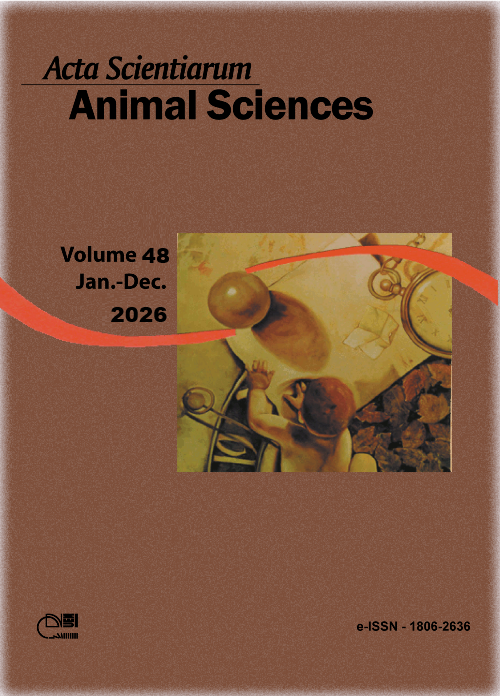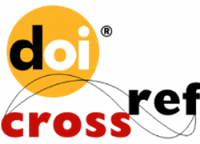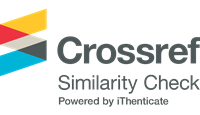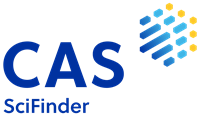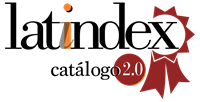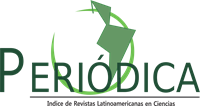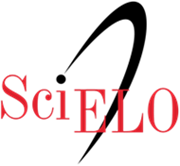Postpartum uterine and ovarian condition affect the foal estrus fertility in Mangalarga Marchador mares?
Abstract
This study was conducted to evaluate the follicle development, uterine morphology, and fertility of Mangalarga Marchador mares submitted to natural breeding in the first postpartum estrous cycle. Eight mares were evaluated with ultrasound equipment every three days, from the second to the 42nd day after delivery. During this period, follicular diameter, corpus luteum persistence, appearance and diameter of the horns and uterine body in addition to weight and body condition were evaluated. Postpartum reproductive efficiency was verified through conception and estrous repetition rates. Data were submitted to Pearson's correlation analysis, chi-square test, linear and quadratic regression. Ovulation occurred between days 14.5 ± 2.5 postpartum. The mean range of the follicular wave was 11.75 ± 2.5 days, with a daily follicular growth rate of 3.6 ± 0.6 mm. There was reduction of the uterine body of 20.6 ± 1.4 mm, characterizing uterine involution in mares. High conception rate (75%) was found during foal heat and variation in body weight and body condition score after parturition did not present significant interference in the other parameters. Therefore, follicular dynamic, uterine involution, weight, and body condition variation were compatible with the postpartum estrus onset in Mangalarga Marchador mares and did not interfere in conception rates.
Downloads
References
Abdelnaby, E. A., & El-Maaty, A. M. A (2017). Dynamics of follicular blood flow, antrum growth, and angiogenic mediators in mares from deviation to ovulation. Journal of Equine Veterinary Science, 55, 51-59. https://doi.org/10.1016/j.jevs.2017.04.003
Allen, W. R. (2005). Maternal recognition and maintenance of pregnancy in the mare. Animal Reproduction, 2(4), 209-223.
Alvares, C. A., Stape, J. L., Sentelhas, P. C., Gonçalves, J. L. M., & Spavorek, G. (2013). Köppen’s climate classification map for Brazil. Meteorol Zeitschrift, 22(6), 711-728. https://doi.org/10.1127/0941-2948/2013/0507
Angrimani, D. S. R., Rui, B.R., Cruz, L.V., Romano, R. M., & Lopes, H. C. (2011). Retenção de placenta em vacas e éguas: revisão de literatura. Revista Científica Eletrônica de Medicina Veterinária, 9(16), 1-12.
Barros, B. S., & Oliveira, R. A. (2017). Cio do potro: o que é e quando utilizar? Revista Brasileira de Reprodução Animal, 41(3), 665-670.
Blanchard, T. L., & Macpherson, M. (2011). Breeding mares on foal heat. In A. O. Mckinnon, E. L. Squires, W. E. Vaala, & D. D. Varner (Eds.), Equine reproduction (pp. 2294-2301). Blackwell Publishing.
Buratini, J., Rosa e Silva, A. A., Barros, C. M., Pappa, F. O., Caldas, M. C., & Meira, C. (1997). Follicular dynamics in Mangalarga mares. Equine Veterinary Journal Supplements, 29(1),7-11. https://doi.org/10.1111/j.2042-3306.1997.tb05091.x
Davies Morel, M. C. G., Newcombe, J. R., & Hinchliffe, J. (2009). The relationship between consecutive pregnancies in thoroughbred mares. Does the location of one pregnancy affect the location of the next, is this affected by mare age and foal heat to conception interval or related to pregnancy success. Theriogenology, 71(7), 1072-1078. https://doi.org/10.1016/j.theriogenology.2008.11.010
Dini, P., Ducheyne, K., Lemahieu, I., Wambacq, W., Vandaele, H., & Daels, P. (2019). Effect of environmental factors and changes in the body condition score on the onset of the breeding season in mares. Reproduction in Domestic Animals, 54(7), 987-995. https://doi.org/10.1111/rda.13452
Duguma, A., & Lemma, A. (2020). Ovarian follicular dynamics and uterine changes during the ovulatory wave predicts imminent ovulation in Mares. International Journal of Veterinary Science and Research, 6(1), 41-46. http://dx.doi.org/10.17352/ijvsr.000052
Falomo, M. E., Del Re, B., Rossi, M., Giaretta, E., Dalt, L.D., & Gabai, G. (2020). Relationship between postpartum uterine involution and biomarkers of inflammation and oxidative stress in clinically healthy mares (Equus caballus). Heliyon. 6(4), e03691. https://doi.org/10.1016/j.heliyon.2020.e03691
Gibson, D. A., Simitsidellis, I., Collins, F., & Saunders, P. T. K. (2018). Endometrial intracrinology: oestrogens, androgens and endometrial disorders. International Journal of Molecular Sciences, 19(10), 3276. https://doi.org/10.3390/ijms19103276
Ginther, O. J., Beg, M. A., Gastal, M. O., & Gastal, E. L. (2004). Follicle dynamics and selection in mares. Animal Reproduction, 1(1), 45-63.
Henneke, D. R., Potter, G. D., Kreider, J. L., & Yeates, B. F. (1983). Relationship between condition score, physical measurements and body fat percentage in mares. Equine Veterinary Journal, 15(4), 371-372. https://doi.org/10.1111/j.2042-3306.1983.tb01826.x
Lemes, K. L., Silva, L. A., Alonso, M. A., Celeghini, E. C. C., Pugliesi, G., Carvalho, H. F., Affonso, F. J., Silva, D. F., Leite, T. G., & Arruda, R. P. (2017a). Uterine vascular perfusion and involution during the postpartum period in mares. Journal of Equine Veterinary Science, 51(1), 61-69. https://doi.org/10.1016/j.jevs.2016.10.010
Lemes, K. L., Silva, L. A., Alonso, M. A., Celeghini, C.C.E., Pugliesi, G., Carvalho, H. F., Affonso, F. J., Silva, D. F., Leite, T. G., & Arruda, R. P. (2017b). Follicular dynamics, ovarian vascularity and luteal development in mares with early or late postpartum ovulation. Theriogenology, 96(1), 23-30. https://doi.org/10.1016/j.theriogenology.2017.03.020
Mazhitova, A. T., Kulmyrzaev, A. A., Ozbekova, Z. E., & Bodoshev, A. (2015). Amino acid and fatty acid profile of the mare’s milk produced on suusamyr pastures of the kyrgyz republic during lactation period. Procedia Social and Behavioral Sciences, 195(3), 2683-2688. https://doi.org/10.1016/j.sbspro.2015.06.479
Peugnet, P., Duchamp, G., Reigner, F., & Dupont, J. (2010). Effect of growth hormone treatment on follicular growth in well-fed or feed-restricted mares. Animal Reproduction Science, 121(1-2), 42-44. https://doi.org/10.1016/j.anireprosci.2010.04.189
Rodrigues, P. G., Raymundo, C. M., Souza, J. C., Miranda, M. C. M. G., & Rezende, A., S. C. (2011). Gordura corporal e eficiência reprodutiva em éguas doadoras de embrião Mangalarga Marchador. Ciência e Agrotecnologia, 5(5), 1002-1008. https://doi.org/10.1590/S1413-70542011000500019
Rua, M. A. S., Quirino, C. R., Matos, L. F., Rodrigues, A. C. C., & Bartholazzi Junior, A. (2019). Environmental effects and repeatability of the follicular diameter in mares. Revista Brasileira de Zootecnia, 48, e20190047. https://doi.org/10.1590/rbz4820190047
Satué, K., & Gardón, J. C. (2013). A review of the estrous cycle and the neuroendocrine mechanisms in the mare. Journal of Steroids and Hormonal Science, 4(2), 1-8. https://doi.org/10.4172/2157-7536.1000115
Sharma, S., Davies Morel, M. D. G., & DhaliwaL, G. S. (2010). Factors affecting the incidence of postpartum estrous, ovarian activity and reproductive performance in Thoroughbred mares bred at foal heat under Indian subtropical conditions. Theriogenology, 74(1), 90-99. https://doi.org/10.1016/j.theriogenology.2010.01.018
Valacchi, G., Virgili, F., Cervellati, C., & Pecorelli, A. (2018). OxInflammation: from subclinical condition to pathological biomarker. Frontiers in Physiology, 9, 1-15. https://doi.org/10.3389%2Ffphys.2018.00858
Zúccari, C. E. S. N., Bender, E. S. C., Costa e Silva, E. V. C., & Saturnino, H. M. (2013). Eficiência reprodutiva e dinâmica folicular de éguas Campolina de acordo com a condição corporal. Ciência Animal Brasileira,14(4), 406-412. https://doi.org/10.5216/cab.v14i4.17693
Copyright (c) 2026 Hanna Gabriela Oliveira Maia, Lúcio Tolentino Amaral Júnior, Felipe Gomes da Silva; Gustavo Leal Teixeira; Neide Judith Faria de Oliveira, Letícia Ferrari Crocomo

This work is licensed under a Creative Commons Attribution 4.0 International License.
DECLARATION OF ORIGINALITY AND COPYRIGHTS
- I Declare that current article is original and has not been submitted for publication, in part or in whole, to any other national or international journal.
The copyrights belong exclusively to the authors. Published content is licensed under Creative Commons Attribution 4.0 (CC BY 4.0) guidelines, which allows sharing (copy and distribution of the material in any medium or format) and adaptation (remix, transform, and build upon the material) for any purpose, even commercially, under the terms of attribution.
Read this link for further information on how to use CC BY 4.0 properly.




